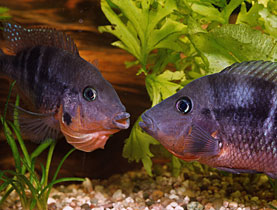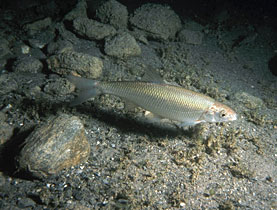Evolution is in the eye of the beholder

Eye and hair colour play a role in human partner choice, but visual stimuli can also determine mating preferences in the animal kingdom, scientists have discovered.
In many species the male’s mating fortunes are decided by looking impressive. A study of brightly coloured fish has now shown that this has less to do with aesthetics than with the sensitivity of female eyes, which varies as a result of adaptation to the environment.
Researchers at the Swiss Federal Institute of Aquatic Science and Technology found that females more attuned to blue will choose a metallic blue mate, while those better able to see red will prefer a bright red male.
Ole Seehausen, an evolutionary biologist at the institute on the shores of Lake Lucerne, and his team found that some colourful cichlid fish in Africa’s Lake Victoria formed a new species by adapting their vision, showing that geographical isolation is not essential for divergence.
The cichlids – pronounced “sick-lids” – evolved to improve their ability to see food and predators at different depths, and this also affected the way they saw colours and attracted mates, said Seehausen, who led the study published in the journal Nature.
“The split of one species into two was initiated by adaptation of the sensory system, in this case the eyes, to the local environment,” he said.
Cichlids are an important model for evolutionary biologists because no other group of vertebrates has split into so many species – about 2,000 – so quickly, Seehausen said.
Scientists also generally believe that originating a new species requires geographical isolation – such as two continents drifting apart. The fact that the two different cichlid fish species live side by side is puzzling, he said.
“These fish meet each other all the time and really live in the same spot,” he said. “We knew there were two different species but we didn’t know how that came about.”
Implications
The findings have implications for conservation efforts because they suggest that pollution that changes the light in the water would lead the two species to collapse and merge into a single one, Seehausen said.
The findings, and the introduction of a predatory fish, “help explain the very rapid loss of cichlid species in Lake Victoria over the past 30 years,” Seehausen said, adding that the number of species there had fallen by half from 500.
The researchers looked at two species, marked by their red or blue colours, found off five islands throughout the lake.
They determined through laboratory experiments that certain genetic mutations helped some fish adapt their vision at deeper levels to see the colour red, and others in shallower water to recognise shades of blue.
That gave blue males a mating advantage in shallower water and red ones an edge in deeper parts of the lake because they were more attractive to female fish.
“In short, what you see determines what you get, and with whom you get it on,” Mark Kirkpatrick of Texas University and Trevor Price of Chicago University wrote in a Nature commentary.
swissinfo with agencies
Cichlids are fish from the family Cichlidae in the order Perciformes. There are an estimated 2,000 species, with many more being discovered every year.
Cichlids have evolved to be very efficient feeders that are able to capture and process a very wide variety of food items. This is assumed to be one reason why they are so diverse – cichlid species range from 2.5 cm in length to approaching one metre.
They are largely freshwater fish and are less commonly found in brackish and salt water habitats, though many species will tolerate brackish water for extended periods.
All living organisms – from humans to mountain goats to edelweiss – are distant cousins and have evolved, through random genetic mutations and the non-random process of natural selection, from a single self-replicating molecule that popped into existence by chemical chance some 3.5 billion years ago.
In natural selection, organisms which evolve traits favourable to survival in their environment reproduce more than rivals. Thus genes that build successful survival machines get passed on more than less successful genes.
Evolution via natural selection thus explains how simple organisms can, over millions of years, result in complex organisms seemingly designed for their environment without requiring any supernatural “designer”.

In compliance with the JTI standards
More: SWI swissinfo.ch certified by the Journalism Trust Initiative










You can find an overview of ongoing debates with our journalists here . Please join us!
If you want to start a conversation about a topic raised in this article or want to report factual errors, email us at english@swissinfo.ch.